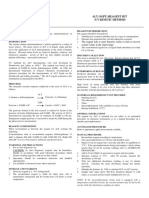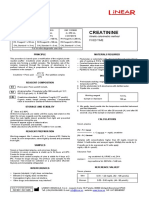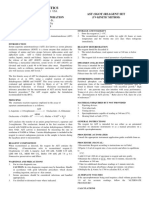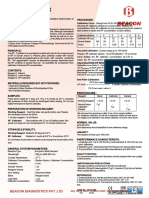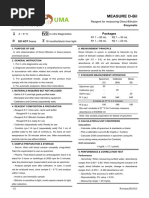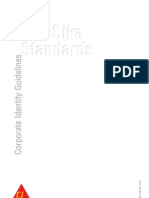Measure Amy
Measure Amy
Uploaded by
tuan vănCopyright:
Available Formats
Measure Amy
Measure Amy
Uploaded by
tuan vănOriginal Title
Copyright
Available Formats
Share this document
Did you find this document useful?
Is this content inappropriate?
Copyright:
Available Formats
Measure Amy
Measure Amy
Uploaded by
tuan vănCopyright:
Available Formats
UMA CO., LTD.
MEASURE AMYG7
2-19-6 Yokosuka Reagent for measuring Amylase Activity
Matsudo, Chiba, Japan G7CNP IFCC Method
á 2 ~ 8 °C IVD In vitro Diagnostics Packages
R1 1 ´ 60 mL R2 1 ´ 12 mL
T DO NOT freeze 6 18 months/block from light R1 5 ´ 60 mL R2 5 ´ 12 mL
1. PURPOSE OF USE 6. MEASUREMENT PRINCIPLE
In vitro Determination of Amylase in blood serum, blood α-Amylase reacts with substrate ethylidene-4-
plasma or urine. nitrophenol-G7 (maltoheptaose) [ethylidene-G7
(maltoheptaose)-PNP] and isolates nitrophenol
2. GENERAL INSTRUCTION
compounds.
1. For in vitro diagnostics use only.
When α-glucosidase coexists with this reaction system,
2. Diagnosis should be made in a comprehensive manner,
in accordance with other related test results and clinical p-nitrophenol (PNP) is generated by reaction. Activity of
α-amylase can be obtained by measuring change of
symptoms by the doctor in attendance.
absorbance of PNP.
3. For guaranteed results, usage of this product must
comply with the instruction in this manual. 7. STANDARD MEASUREMENT OPERATION
4. For automatic analyzers: follow their instructions. Specimen Calibrator Blank
3. MATERIALS REQUIRED BUT NOT INCLUDED (S) (Std) (B)
- Saline 0.9 % and high grade purified water Specimen (µL) 40 - -
- Micropipet and other basic laboratory equipment. Calibrator (µL) - 40 -
- Calibrators and Controls (separatedly sold) Saline (µL) - - 40
R-1 (µL) 1000 1000 1000
4. REAGENT COMPOSITION & PREPARATION
Incubate at 37 °C in 5 minutes
- Reagent R-1: α-glucosidase
R-2 (µL) 200 200 200
Reagent R-1 is ready for use
Mix well; incubate at 37 °C for 5 minutes; measure
- Reagent R-2: ethylidene-4-nitrophenol-G7
absorbance at 405/660 nm
(maltoheptaose) ethylidene-G7 (maltoheptaose)-PNP}
Note: See sample preparation for details of specimen
Reagent R-2 is ready for use
- Calibrators: Kanto TraceCalib PLUS is recommended 8. CALCULATION & UNIT CONVERSION
- Controls Lyo-1 & Lyo-2 (separatedly sold): Put 1 mL of Calculation
purified water to the vials of controls (L, H); leave at room - Calculate ∆Abs of specimen & standards vs blank
temparature for 30 minutes before use. After reconstituted, - Plot a calibration curve AMY (U/L) = f(∆Abs)
controls can be use without dilution. - Calculate AMY concentration in specimen using the
5. SAMPLE PREPARATION & STORAGE curve (doing same procedure for Controls)
- Serum: Wait until sample completly coagulated. Take the Unit conversion
supernatant to use as specimen. 1 U/L = 0.0166 µkat/L
- Plasma: Treat sample by anticoagulant; leave sample to 9. PERFORMANCE & CORRELATION TEST
stand for 3 hours or centrifuge at 2000 rpm for 2 minutes; Performance
take the plasma layer (supernatant) and use as specimen. - Sensitivity: Change in absorbance when measuring
- Urine: Collect in clean cup and cap tightly purified water as sample ranges from 0.00 to 0.01. Change
- Analyze sample soon after collection or store sample 2 ~ in absorbance is 0.035~0.1 Abs/min. when measuring a
8 °C and analyze within 10 days; α-amylase is unstable in standard solution of known amylase activity of 100 ~200
acidic urine, so measure it immediately after collection U/L as sample.
1/2 Revision 11/2015
- Specificity: The accuracy is within ±10.0%. mouth by mistake, wash it immediately with plenty of water
- Reproducibility: CV value < 10.0%. and consult the doctor if needed.
- Measuring range: 2 ~ 2000 U/L. 3. If reagents are spilled, dilute with water and wipe it out. If
(Dilute the samples properly with saline & others which specimen is spilled, spray 80% of alcohol over the
showed high values exceeding upper limit of measuring specimen and wipe it out.
range or samples which are expected to show high values Usage
in advance) 1. Store reagents under specified condition. Do not use
Correlation Test after expiration date.
Same principle (serum): 2. Do not use the container and auxiliaries included in this
Regression equation: Y = 1.0067X – 1.5160 (n=61) kit for other purposes.
Correlation coefficient: R=0.9995 3. Do not mix reagents of different lot for use.
Different principle (serum) 4. Do not add to the reagent being used even if it is the
Regression equation: Y = 1.0129X – .2657 (n=67) same lot number.
Correlation coefficient: R=0.9997 Disposal
Correlation between serum and plasma samples 1. All specimens, as well as all instruments (e.g. test tubes)
Y= 1.0044 X – 1.4353 that come in contact with the specimens, must be treated by
R= 0.9995 (n=61) the following methods, or they must be treated according to
the manual for infectious medical waste provided in each
10. EXPECTED VALUES
- Serum: 37 ~ 125U/L facility.
・ Sterilize with an autoclave, subjecting them to high
- Plasma: 33 ~ 120 U/L
- Urine: 50 ~ 500 U/L pressure saturated steam at 121 °C for more than 20
minutes. Do not process waste containing sodium
Reference range should be established at each facility and
hypochlorite solution with an autoclave.
judgement should base on measurement results in a
・Immerse at least one hour in sodium hypochlorite solution
comprehensive manner together with clinical symptoms
(active chloride concentration of over 1000 ppm).
and other measurement results.
2. This reagent contains sodium azide. Sodium azide can
11. INTERFERENCES
react with lead pipe and/or steel pipe and can generate
- No influence is observed by hemoglobin up to 500 mg/dL,
explosive metal azide. Make sure to use plenty of water at
bilirubin up to 60 mg/dL and ascorbic Acid up to 100 mg/dL.
disposal. Concentration of sodium azide in R-2 is 0.05%.
12. INFORMATION FOR AUTOANALYZERS 14. OTHER INSTRUCTIONS AND CAUTION
Calculation Method Rate - Results may differ depending on the sample/reagent
ratio. Adjust parameters for different analyzer.
Temperature 37 °C
- Prepare the calibration curve on the day of
Specimen 5
determination.
Volume (μL) R1 150
R2 30
Main 405
Wavelength (nm)
Sub- 660
Point 1 10
Measurement
Point 2 24
(cycle) Point 3 34
Calibration type Linear
Unit U/L
13. HANDLING, USAGE & DISPOSAL
Handling
1. Specimen can be potentially positive for infectious agents
including hepatitis B virus and HIV. Wear glove and goggle
when needed.2. In case reagents got into skin, eye or
2/2 Revision 11/2015
You might also like
- An Explanation of Sail Flow AnalysisDocument10 pagesAn Explanation of Sail Flow Analysiskaltne23100% (1)
- Experimental approaches to Biopharmaceutics and PharmacokineticsFrom EverandExperimental approaches to Biopharmaceutics and PharmacokineticsNo ratings yet
- Volume 3 - The Sectoral StudiesDocument168 pagesVolume 3 - The Sectoral Studiespepito manalotoNo ratings yet
- Measure H-FabpDocument2 pagesMeasure H-Fabptuan vănNo ratings yet
- Measure TbaDocument2 pagesMeasure Tbatuan vănNo ratings yet
- Measure NagDocument2 pagesMeasure Nagtuan vănNo ratings yet
- MEASURE D-DimerDocument2 pagesMEASURE D-Dimertuan vănNo ratings yet
- MEASURE AST (Fixed)Document2 pagesMEASURE AST (Fixed)Trần Văn BìnhNo ratings yet
- MEASURE HbA1c (Fixed)Document2 pagesMEASURE HbA1c (Fixed)Trần Văn Bình100% (1)
- 1.alpha AmylaseDocument2 pages1.alpha AmylaseHiếu Chí PhanNo ratings yet
- MEASURE ALT (Fixed)Document2 pagesMEASURE ALT (Fixed)Trần Văn BìnhNo ratings yet
- Measure UaDocument2 pagesMeasure Uatuan vănNo ratings yet
- AmylaseDocument1 pageAmylasePhong Nguyễn WindyNo ratings yet
- 1151010I Rev. 04Document2 pages1151010I Rev. 04kirubel demelashNo ratings yet
- GPTDocument2 pagesGPT徳利雅100% (1)
- 1105000I Rev. 02Document2 pages1105000I Rev. 02Riadh BenyoucefNo ratings yet
- MEASURE D-DimerDocument2 pagesMEASURE D-Dimertuan vănNo ratings yet
- Mxbeis27 Amilase 2017Document4 pagesMxbeis27 Amilase 2017Gabriel99601 [Rapidos y Rabiosos] BkknNo ratings yet
- SGPT CrestlineDocument2 pagesSGPT CrestlineJashmyn JagonapNo ratings yet
- Lipase Spinreact 1x24 ML, 1X48 MLDocument2 pagesLipase Spinreact 1x24 ML, 1X48 MLN. K. MandilNo ratings yet
- Measure GluDocument2 pagesMeasure Glutuan vănNo ratings yet
- MEASURE PG II - NewDocument2 pagesMEASURE PG II - Newtuan vănNo ratings yet
- a1-anti tripsina pntDocument4 pagesa1-anti tripsina pntumaps2006No ratings yet
- KR10060Document2 pagesKR10060KOUAME EDYMAIN FRANCISNo ratings yet
- KIT INSERT ALT GPTDocument2 pagesKIT INSERT ALT GPTmustakim gmaNo ratings yet
- Uma Co., Ltd. Measure Alb: 2-19-6 Yokosuka Matsudo, Chiba, Japan Bromocresol Green MethodDocument2 pagesUma Co., Ltd. Measure Alb: 2-19-6 Yokosuka Matsudo, Chiba, Japan Bromocresol Green MethodNguyễn Phương NgọcNo ratings yet
- Clonatest Amylase MRDocument4 pagesClonatest Amylase MRSuprovet LabotatorioNo ratings yet
- MEASURE TP (Fixed)Document2 pagesMEASURE TP (Fixed)Trần Văn BìnhNo ratings yet
- UREA Berthelot: REF 1156010 REF 1156015Document2 pagesUREA Berthelot: REF 1156010 REF 1156015Wael ChasibNo ratings yet
- Amylase: Quantitative Determination of - Amylase (AMS)Document2 pagesAmylase: Quantitative Determination of - Amylase (AMS)Nolberto Robles100% (1)
- 1126005I Rev. en KR 04Document2 pages1126005I Rev. en KR 04Nguyễn HuynhNo ratings yet
- Reagen DiaSys Asam UratDocument2 pagesReagen DiaSys Asam UratTammy NurhardiniNo ratings yet
- Pi e AP Ifcc 2Document2 pagesPi e AP Ifcc 2muhammadsufyanfp12No ratings yet
- Alpha-Amylase: For In-Vitro Diagnostic and Professional Use OnlyDocument2 pagesAlpha-Amylase: For In-Vitro Diagnostic and Professional Use OnlyPark YuriNo ratings yet
- Alp PDFDocument1 pageAlp PDFDhita Ariefta PNo ratings yet
- Protap - Amylase (Dyasis)Document2 pagesProtap - Amylase (Dyasis)TEMPORALIS 2018No ratings yet
- ALP Crestline PDFDocument2 pagesALP Crestline PDFJashmyn JagonapNo ratings yet
- CreatinineDocument2 pagesCreatininebudiNo ratings yet
- Measure PG IDocument2 pagesMeasure PG INguyen TuanNo ratings yet
- PotasiumDocument2 pagesPotasiumlabextreme29No ratings yet
- 6.POTASSIUM EnzymaticDocument2 pages6.POTASSIUM EnzymaticHiếu Chí PhanNo ratings yet
- Budi Altgpt - Doc NewDocument3 pagesBudi Altgpt - Doc NewIrvanda ENVIOUSNo ratings yet
- AlkPhos FL 51 SFBC TV-005-CE-003Document1 pageAlkPhos FL 51 SFBC TV-005-CE-003Blas Cuba SanchezNo ratings yet
- Alp Mono VialsDocument3 pagesAlp Mono VialsN. K. MandilNo ratings yet
- Alkaline Phosphatase (Dea) : Manufacturer: Biolabo SasDocument2 pagesAlkaline Phosphatase (Dea) : Manufacturer: Biolabo SasRury Darwa Ningrum100% (1)
- MEASURE D-Dimer (Fixed)Document2 pagesMEASURE D-Dimer (Fixed)Trần Văn BìnhNo ratings yet
- 1116005I Rev. 02Document2 pages1116005I Rev. 02kirubel demelashNo ratings yet
- PI e UA - TOOS 19Document2 pagesPI e UA - TOOS 19labor baiturrahimNo ratings yet
- 1141010I Rev. 02Document2 pages1141010I Rev. 02Nguyễn HuynhNo ratings yet
- PI e CREA - JAFFE 19Document2 pagesPI e CREA - JAFFE 19Salsabila Nur OktavianiNo ratings yet
- SGOT CrestlineDocument2 pagesSGOT CrestlineJashmyn JagonapNo ratings yet
- Turbitex ASL: Antistreptolysin-ODocument4 pagesTurbitex ASL: Antistreptolysin-ODarko MaksimovicNo ratings yet
- RF TurbilatexDocument1 pageRF TurbilatexSud007jbNo ratings yet
- ASO APT AbDocument2 pagesASO APT AbQC LabNo ratings yet
- Asat (Got) Fs : Order Information Warnings and PrecautionsDocument6 pagesAsat (Got) Fs : Order Information Warnings and PrecautionsTesya PratiwiNo ratings yet
- Prothrombin Time plus - IFUDocument3 pagesProthrombin Time plus - IFUsalehumanicNo ratings yet
- GA4960 00 - Urea UV - 0Document2 pagesGA4960 00 - Urea UV - 0Abdalrhman FarajNo ratings yet
- Acid Phosphatase (Acp)Document1 pageAcid Phosphatase (Acp)Risqon Anjahiranda AdiputraNo ratings yet
- MEASURE D-BilDocument2 pagesMEASURE D-Biltuan vănNo ratings yet
- Measure TCDocument2 pagesMeasure TCtuan vănNo ratings yet
- 1133505I Rev. 04Document2 pages1133505I Rev. 04Nguyễn HuynhNo ratings yet
- Quantitative Determination of Alkaline Phosphatase (ALP) IVDDocument1 pageQuantitative Determination of Alkaline Phosphatase (ALP) IVDPhong Nguyễn WindyNo ratings yet
- High-Density Lipoprotein (HDL) - (PDF - Io)Document1 pageHigh-Density Lipoprotein (HDL) - (PDF - Io)tuan vănNo ratings yet
- C-Reactive Protein (CRP) HSDocument1 pageC-Reactive Protein (CRP) HStuan vănNo ratings yet
- Glycohemoglobin Reagent SetDocument4 pagesGlycohemoglobin Reagent Settuan vănNo ratings yet
- Total Iron-Binding Capacity (TIBC)Document4 pagesTotal Iron-Binding Capacity (TIBC)tuan vănNo ratings yet
- PotassiumDocument4 pagesPotassiumtuan vănNo ratings yet
- CreatinineDocument1 pageCreatininetuan vănNo ratings yet
- Urea Nitrogen (BUN)Document5 pagesUrea Nitrogen (BUN)tuan vănNo ratings yet
- TriglyceridesDocument5 pagesTriglyceridestuan vănNo ratings yet
- Alanine Aminotransferase (ALT or SGPT)Document1 pageAlanine Aminotransferase (ALT or SGPT)tuan vănNo ratings yet
- LMV358M bảng dữ liệu, LMV358M view - - - ALLDATASHEET - - -Document27 pagesLMV358M bảng dữ liệu, LMV358M view - - - ALLDATASHEET - - -tuan vănNo ratings yet
- AmylaseDocument1 pageAmylasetuan vănNo ratings yet
- Measure HDLDocument2 pagesMeasure HDLtuan vănNo ratings yet
- Measure UnDocument2 pagesMeasure Untuan vănNo ratings yet
- Measure TPDocument2 pagesMeasure TPtuan vănNo ratings yet
- BH2Document1 pageBH2tuan vănNo ratings yet
- Module 2 (p1) - The Teacher As A Knower of CurriculumDocument58 pagesModule 2 (p1) - The Teacher As A Knower of CurriculumTRISHA MAY LIBARDOS100% (1)
- Application - MixingDocument2 pagesApplication - MixingPatrick LaurinaNo ratings yet
- Cream Puff Recipe Ingredients: Choux PastryDocument2 pagesCream Puff Recipe Ingredients: Choux Pastryهيدايو کامارودينNo ratings yet
- Sr.C-120 & C-IPL - JEE-Main-RCTM-03 - Q.PAPERDocument13 pagesSr.C-120 & C-IPL - JEE-Main-RCTM-03 - Q.PAPERvisheshNo ratings yet
- Self Care Dr. AntolakDocument7 pagesSelf Care Dr. AntolaktashalaceyNo ratings yet
- Brother P-Touch 60, 65 Parts ManualDocument18 pagesBrother P-Touch 60, 65 Parts ManualDuplessisNo ratings yet
- Gold Class Menu - May - 2024 - STANDARDDocument2 pagesGold Class Menu - May - 2024 - STANDARDEddy TangNo ratings yet
- Tug of War Game MechanicsDocument1 pageTug of War Game MechanicsAhmed-Adhiem Bahjin Kamlian100% (1)
- Bab 1Document5 pagesBab 1emeldagraceNo ratings yet
- Ascendant CalculationDocument1 pageAscendant Calculationindians jonesNo ratings yet
- Gypsum Products - DR MehvishDocument17 pagesGypsum Products - DR Mehvishabdul.moiz3323No ratings yet
- Full Download Rocks Gems and Minerals 3rd Edition Garret Romaine PDF DOCXDocument50 pagesFull Download Rocks Gems and Minerals 3rd Edition Garret Romaine PDF DOCXdubinpulecu6100% (4)
- Lesson Plan Fonn S.4Document7 pagesLesson Plan Fonn S.4Sandeep MeenaNo ratings yet
- Cardox CivilsDocument9 pagesCardox CivilsaaspathisNo ratings yet
- Flashing LightsDocument95 pagesFlashing LightsJoey PayneNo ratings yet
- English Speaking CountryDocument16 pagesEnglish Speaking CountryKamilla NizamovaNo ratings yet
- Determination of Fragments of Multiaxial Service Loading Strongly Influencing The Fatigue of Machine ComponentsDocument10 pagesDetermination of Fragments of Multiaxial Service Loading Strongly Influencing The Fatigue of Machine Componentspaulocouceiro100% (1)
- Lightning Falling All Around Me (1995-1996)Document118 pagesLightning Falling All Around Me (1995-1996)arkansaswits100% (1)
- Corporate Identity ManualDocument54 pagesCorporate Identity ManualAleksandra Ruzic75% (4)
- batteries-10-00337Document11 pagesbatteries-10-00337AhmedsharifMohammedNo ratings yet
- Entresto Uses, Dosage, Side Effects & WarningsDocument6 pagesEntresto Uses, Dosage, Side Effects & WarningspatgarettNo ratings yet
- Sociology WorksheetDocument1 pageSociology WorksheetMithileshNo ratings yet
- Zulu BeadworkDocument8 pagesZulu Beadworkeugene_970418755No ratings yet
- Blue Papers: Oiz OmrDocument21 pagesBlue Papers: Oiz OmrsereucaNo ratings yet
- Phytochemistry: Nadine Strehmel, Christoph Böttcher, Stephan Schmidt, Dierk ScheelDocument12 pagesPhytochemistry: Nadine Strehmel, Christoph Böttcher, Stephan Schmidt, Dierk ScheelMuhamad Ilfan AlwirudinNo ratings yet
- Measurement and MotionDocument6 pagesMeasurement and Motionbittuchintu100% (3)
- EDM132-FinalDocument97 pagesEDM132-FinalPUTLI UDTOGNo ratings yet
- Uas English 6Document4 pagesUas English 6ss.dirgaaNo ratings yet














